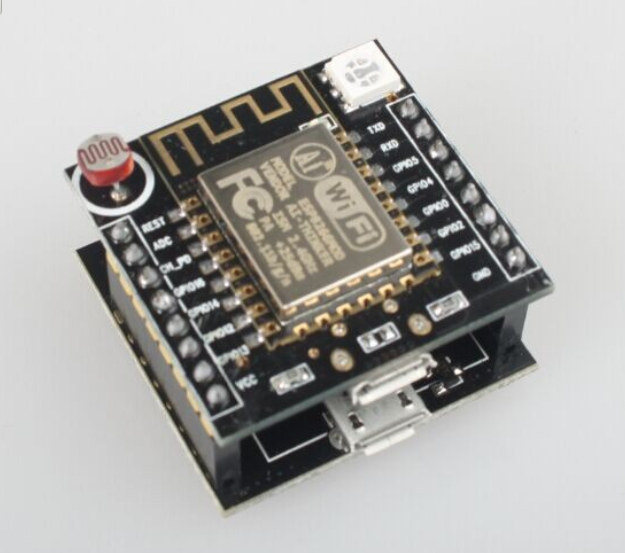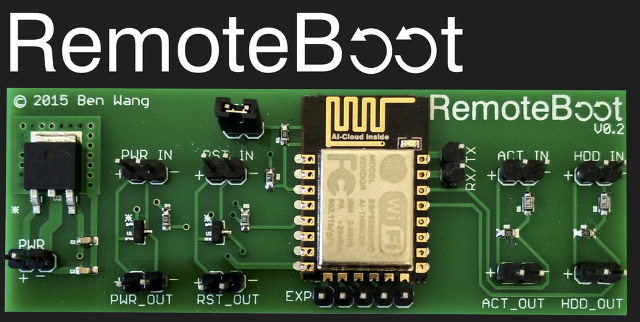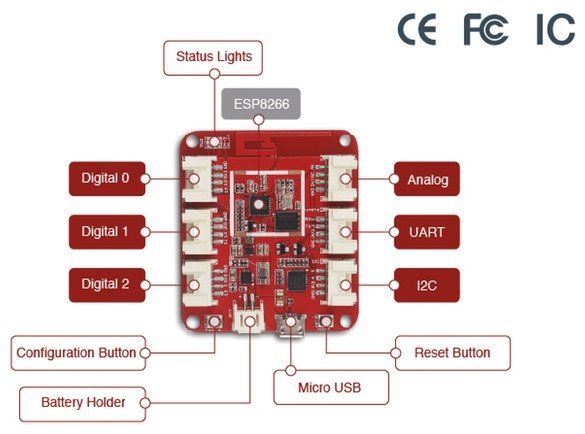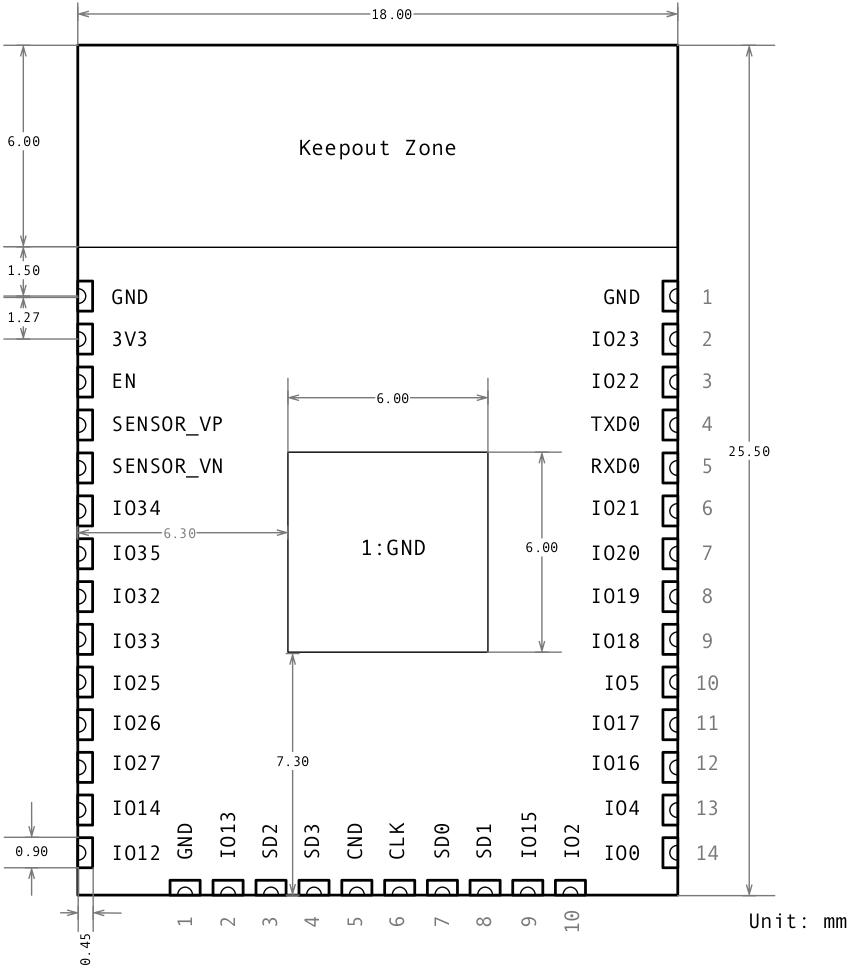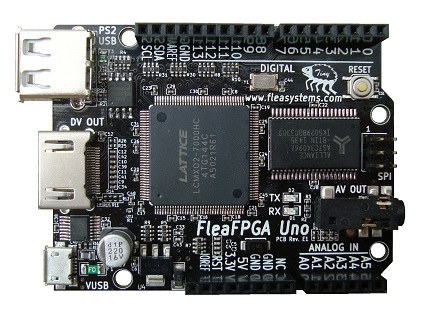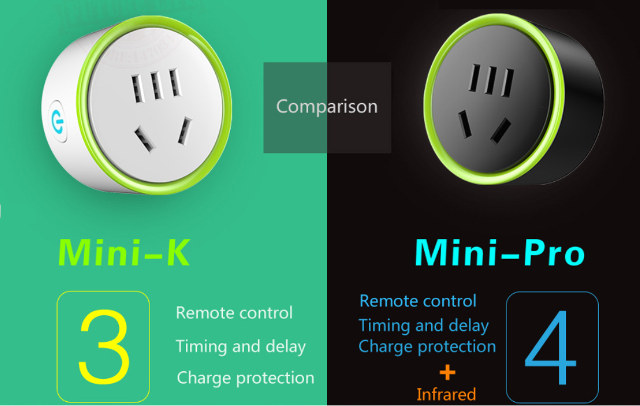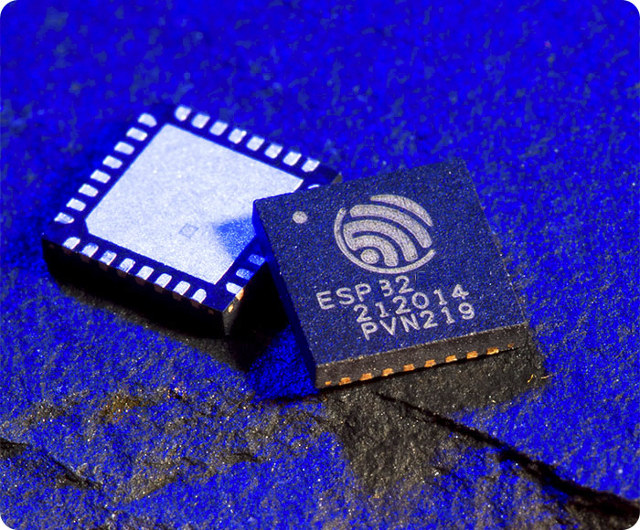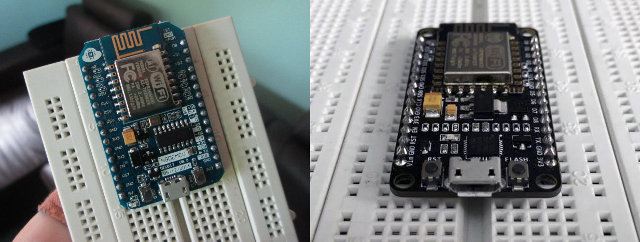In case you need a cheap and compact ESP8266 board with integrated USB to TTL debug interface, a photo resistor, and/or some buttons, a white brand board based on ESP-12F could be interesting. “Witty cloud” development board specifications: ESP-12F module with Espressif ESP8266EX SoC Connectivity – WiFi 802.11 b/g/n 2x 8-pin headers with GPIOs, VCC, GND, Reset, ADC, and UART USB – 2x micro USB port (one for power, one for debugging ?) Misc – Photo resistor, RGB LED, three buttons for power, reset and firmware upgrade (I think) Dimensions – Small Witty cloud might not be the same of the board itself, but could be a cloud service launched in China, as some of the screenshot on Aliexpress could imply. All I could find are some websites vaguely mentioning GoKit 3.0 and Witty Cloud 3.0, but it does not make much sense. If Chinese readers could provide some insights […]
RemoteBoot is an ESP8266 based Board to Power on or Reboot Your Computer over WiFi (Crowdfunding)
Wake-on-LAN is a features that allows you to remotely start your computer by sending magic network packets to the LAN interface, but it requires support from your motherboard. So Ben Wang, an Australian high-school student, decided to make his own little board called RemoteBoot to power off and reboot computers that do not support the feature, or even access the serial console on embedded boards. The board is pretty basic and includes an ESP8266 module: ESP12-E WiFi module 2x digital switching outputs for power and reset buttons 2x digital protected inputs for power and activity LEDs 3x extra general purpose inputs/outputs broken out Tx/Rx for serial console There’s also a feature disabled by default, where a watchdog monitor the activity LED, and automatically reboots the computer after a user-defined timeout. Everything will be control via a simple web interface, and if you have multiple RemoteBoot devices, access to Remoteboot Cloud […]
Wio Link is an ESP8266 Board Designed to Make IoT Projects Easier (Crowdfunding)
There are already plenty of board or modules based on Espressif ESP8266 WiFi SoC, but if you don’t like soldering, or would rather avoid breadboards and some cables for your or your kids’ projects, Wio Link may be interesting, as all you need to is to connect Grove modules required for your applications to get started, and Seeed Studio also took care of the low level software part and a drag-and-drop mobile app is provided, so software programming has been made easy too. Wio Link hardware specifications: SoC – Espressif ESP8266EX Tensila SoC Storage – 4MB flash Connectivity – 802.11b/g/n WiFi, with WEP/TKIP/AES encryption support Expansion – 6x Grove connectors: 3x digital, 1x analog, 1x UART and 1x I2C (3.3V I/Os) Power Supply 5V via micro USB port 3.4 ~ 4.2V via external battery Output DC Current – 1000mA MAX Charge Current: 500mA MAX Dimensions – 55mm*48mm Weight – 26g […]
ESP32 Module Schematics and Board Files
Espressif teased about their ESP32 WiSoC with WiFi and Bluetooth LE a few weeks ago in a letter addressed to developers, but did not release that much information. The company has now released some documents in the forums (registration required) concerning ESP32 module including PCB processing requirement, schematics and PCB layout, and bill of materials. The very first modules will actually be based on ESP31 processor, which only slightly differs from ESP32 with some swapped pins. The BoM is pretty small with several capacitors and resistors, one inductance, a 26 MHz crystal, ESP31, and a Gigadevice flash. The schematics have been designed with Orcad 16.6, so if you don’t have the program, you can read the schematics with Orcad 16.6 Lite, which is free to download. I’ve also printed the schematics to a PDF file. I’m not sure how to open the .pcb file which should be the module’s PCB […]
FleaFPGA Uno Board Combines a Lattice FPGA, Arduino UNO Form Factor, HDMI Output, and an ESP8266 WiFi Module
FPGA board with Arduino headers are not exactly a rarity, for example Digilent ARTY in a larger form factor, and some developers have designed FPGA boards using Arduino Mega form factor, such as Papilio DUO and Arduissimo. But FleaFPGA Uno is the first Arduino Uno like FPGA board I’ve seen and it includes HDMI output, one USB host port, as well as an optional WiFi module based on ESP8266. FleaFPGA Uno specifications: FPGA – Lattice Semi MachXO2-7000HC with 6864 LUTs, 256 Kbits flash, and 240+54 Kbits SRAM System memory – 512KB 10nsec User SRAM. Storage – 16MB User Flash ROM. Video Output 24-bit Digital Video out via HDMI port up to 800×600 Composite NTSC video via 3.5 mm jack Audio – Stereo audio out via 3.5mm jack. USB 1x micro USB port for power and slave serial port 1x USB 1.1 host port (PS/2 port) On-board USB JTAG for easy […]
Konke Mini K and Mini Pro Wifi Smart Sockets are Based on ESP8266 SoC
ESP8266 WiFi modules are very popular in the maker community, but so far I have not seen it in any devices myself, until I saw a tweet from @EspressifSystem about a Mini K smart socket. A search on Aliexpress lead me to two devices made by Konke, who also made Kankun KK-SP3 WiFi socket, with Mini K and Mini Pro smart sockets. Both models has basically the same features, except Mini-Pro adds infrared support: Connectivity – 802.11 b/g/n Rated Voltage – AC 100-240V 50/60Hz Rated Power – 2200 Watts Rated Current – 10A Charging Protection: Yes Misc – Power button, Infrared (Mini Pro model only) Plug – China / AU plugs Dimensions – 5.1 diameter x 2.7 cm (V0 grade PC material) Weight – 70 grams Both devices support on/off timers, cyclical delays and charge protection (turns off when devices are charged) with the Android or iOS app. I understand […]
Espressif ESP32 Dual Core SoC Features Faster WiFi, Bluetooth 4.0 LE, and More Peripherals
Espressif teased us about a successor to ESP8266 a few months ago that would support both WiFi and Bluetooth Low Energy, and John Lee, working for Espressif Systems, has now sent a letter to ESP8266 developers announcing the new wireless SoC with two Tensilica L108 cores and called ESP32. Espressif ESP32 key improvements over ESP8266: Faster WiFi – Wifi has been upgraded to support HT40 speed (144.4 Mbps) and has a new RF architecture to simplify the application schematics Bluetooth Low Energy and Classic Dual core processor – 2x Tensilica L108 processors clocked at up to 160 MHz Low Power Mode Improvements – ADC conversions, level thresholds, etc.. can now be performed in deep sleep Peripherals – Capacitive touch, ADCs, DACs, I2C. UART, SPI, SDIO, I2S, RMII, PMW, etc… but no USB. More RAM – ~400 KB on-chip RAM Security – Hardware accelerated AES and SSL, and more undisclosed improvements. […]
Getting Started with NodeMCU Board Powered by ESP8266 WiSoC
Since ESP8266 is now so popular, I’ve recently bought a NodeMCU board to try it. I selected this board because the latest version of the board is breadboard-friendly, integrates a USB to serial chip, and it can be powered by a simple USB to micro USB cable. I also noticed a ESP8266 tutorial with NodeMCU firmware by SwitchDoc Labs the other day (using ESP-12 and Adafruit Huzzah), which I applied to my NodeMCU board, but since I encountered a few issues, I decided to report my findings, and write my own little getting started guide to switch on/off LED and GPIOs using a web interface. NodeMCU v0.9 and NodeMCU v1.0 If you are going to purchase a NodeMCU board it’s important to know there are two official versions: NodeMCU v0.9 with ESP-12 module NodeMCU v1.0 with ESP-12E module The main complain about NodeMCU v0.9 is that while it fits on […]


